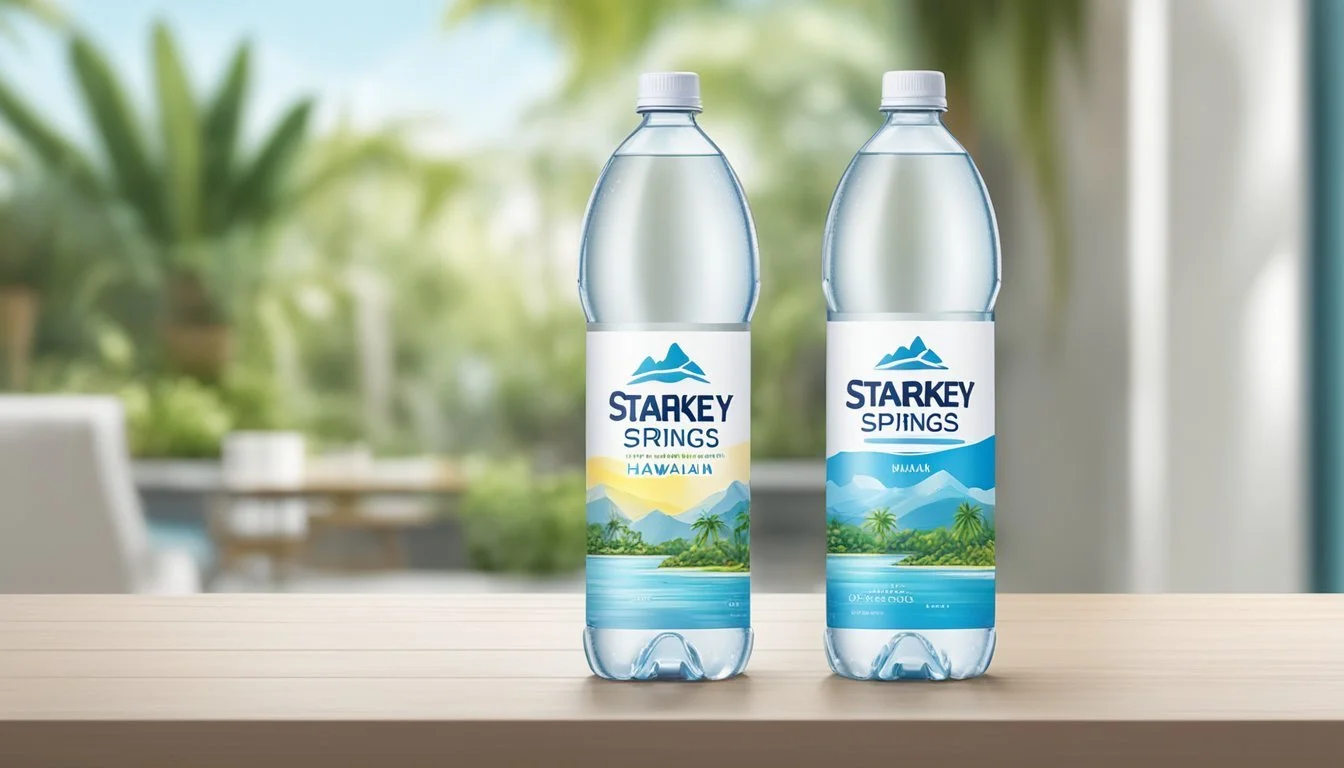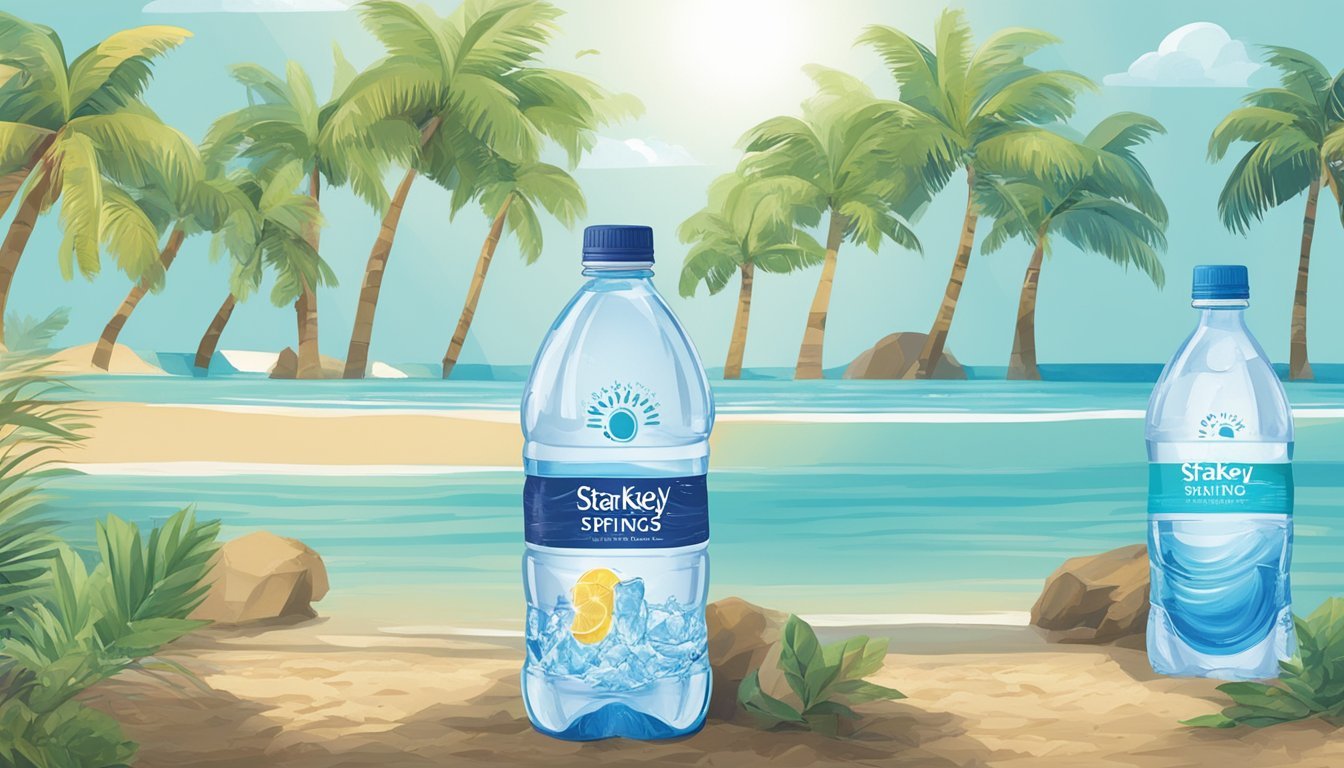Starkey vs. Hawaiian Springs
Which Bottled Water is Better for You?
When it comes to choosing the best bottled water, two brands often stand out: Starkey and Hawaiian Springs. Both boast unique features that cater to different preferences and hydration needs. Starkey is known for its purity and consistent taste, thanks to thorough purification processes. On the other hand, Hawaiian Springs offers naturally filtered water with distinct mineral content, providing a more unique and refreshing experience.
For those prioritizing a pristine and reliable taste, Starkey proves to be the superior option. It excels in delivering clean and purified water that meets high standards. Hawaiian Springs, however, appeals to those who appreciate water rich in natural minerals, which results from its natural filtration process. This natural approach not only enhances the taste but also adds a refreshing quality that sets it apart.
Whether you are a purist or a fan of naturally infused water, the choice between Starkey and Hawaiian Springs ultimately depends on individual preference. Both brands have their unique strengths, making them leaders in the bottled water market.
Origin of Brands
Starkey and Hawaiian Springs offer unique origins that contribute to the distinct characteristics of their bottled water. Both brands are sourced from natural spring water, but their geological settings and formation processes differ significantly.
Starkey Spring: A Geological Marvel
Starkey's water is sourced from a spring in the Rocky Mountains, tapping into geothermal water that has been naturally filtered through volcanic rocks. This gives Starkey water its unique mineral content.
Starkey Spring is located in the foothills of the Ouachita Mountains. The water emerges from deep within the earth, where it absorbs essential minerals. The natural filtration through volcanic rocks ensures purity and enhances the water's taste.
Artifacts suggest that the spring has been valued for centuries, making it a point of scientific interest as well as a sought-after source of premium bottled water.
Water Source and Mineral Content
Understanding how Starkey and Hawaiian Springs source their water and the mineral content they provide is essential for determining which bottled water is better. The following subsections delve into aquifers and natural springs as well as the vital minerals that impact water quality.
Understanding Aquifers and Water Sources
Starkey Water is sourced from a geothermal spring in Idaho. This spring taps into an ancient aquifer deep below the Earth’s surface, providing naturally occurring minerals without the need for additional treatment.
Hawaiian Springs, on the other hand, gathers its water from natural springs in Hawaii. These springs are replenished by rainwater that filters through volcanic rock, which adds unique minerals.
Aquifers act as natural filters, enriching water with essential minerals like calcium and magnesium. Both brands benefit from their unique geological formations but differ in mineral profiles based on their water sources. Understanding these sources provides insight into the natural purity and benefits of each brand.
Minerals: Key to Water Quality
Mineral content plays a significant role in the taste and health benefits of bottled water. Starkey Water contains a notable amount of minerals like calcium, magnesium, and potassium, offering a subtly refreshing flavor and potential health benefits.
Hawaiian Springs also boasts a rich mineral content, with its water containing minerals naturally filtered through volcanic rock. The unique mineral makeup, including calcium and magnesium, gives the water a distinctive and appealing taste.
Comparative Mineral Content:
Mineral Starkey Water (mg/L) Hawaiian Springs (mg/L) Calcium Varies Varies Magnesium Varies Varies Potassium Varies Varies
Delineating each brand's mineral profile highlights their unique attributes, aiding in an informed choice based on mineral preferences and desired health benefits.
Assessing Purity and Quality
When evaluating Starkey and Hawaiian Springs bottled waters, key considerations include the purity, taste, pH levels, and FDA regulations. Each factor plays a crucial role in determining the overall quality and safety of the water.
Total Dissolved Solids and Clean Taste
Total Dissolved Solids (TDS) indicate the concentration of minerals in the water. Starkey water typically has a TDS of around 20-30 ppm (parts per million), which contributes to its clean and fresh taste. Hawaiian Springs, known for being sourced from Hawaiian aquifers, has a TDS around 100-120 ppm, giving it a slightly more mineral-rich flavor.
A lower TDS in Starkey water often results in a crisper taste, favoring consumers who prefer a more neutral profile. Hawaiian Springs' higher TDS suggests a hint of minerality which some find refreshing and indicative of a natural source.
PH Levels and Health Implications
The pH level of water affects its taste and how it interacts with the body. Starkey water has a pH around 9.2, making it alkaline. This is believed by some to help neutralize acidity in the body, though scientific opinions vary on the health benefits.
Hawaiian Springs, on the other hand, generally has a pH level around 7.7, which is also slightly alkaline. This balance is close to the body's natural pH level, making it a good option for everyday hydration without dramatically altering the body's pH balance.
FDA Regulations and Contaminants
Both Starkey and Hawaiian Springs adhere to FDA regulations which set strict limits on contaminants. This ensures the safety and quality of the bottled water. Starkey has faced scrutiny in the past for higher arsenic levels, though subsequent testing generally shows compliance with federal standards.
Hawaiian Springs prides itself on purity, typically surpassing the minimum FDA requirements. Regular testing and transparency reports help assure consumers of its safety. Both brands aim to minimize contaminants, maintaining the highest standards to provide clean, safe drinking water.
Environmental Considerations
Starkey and Hawaiian Springs both claim to prioritize sustainability, but their approaches differ significantly. Key aspects include the types of packaging they use, their overall sustainability initiatives, and the broader impacts on ecosystems.
Eco-Friendly Packaging Choices
Starkey prominently uses glass bottles for its water products. Glass is recyclable and can be reused multiple times without degradation in quality. This choice aligns with an environmentally friendly approach and reduces reliance on single-use plastics.
Hawaiian Springs, on the other hand, primarily utilizes plastic bottles. While some are recyclable, plastic has a considerable environmental footprint.
The packaging differences are substantial when considering environmental sustainability.
Sustainability and Water Brands
Starkey is proactive in promoting sustainability. Their glass bottles contribute to lower carbon emissions compared to traditional plastic packaging. They also support various environmental initiatives to offset their water extraction impacts.
Hawaiian Springs has undertaken efforts to reduce its carbon footprint, focusing on renewable energy for operations and participating in local conservation projects. Yet, their reliance on plastic bottles somewhat undermines these sustainability claims.
Consumers interested in sustainability may find Starkey’s practices more aligned with their values.
Impact on Ecosystems
The water sources for both brands are carefully managed to minimize ecological disruption. Starkey sources its water from geothermal springs, aiming to maintain local biodiversity. Their extraction methods are designed to ensure sustainable use without harming surrounding ecosystems.
Hawaiian Springs obtains its water from aquifers in Hawaii. They emphasize responsible water management to protect local water tables and ecosystems. Yet, the environmental impact of plastic waste remains a significant concern.
Both brands are committed to preserving natural resources, but packaging choices play a crucial role in their ecological footprint.
Consumer Experience
For consumers, the pivotal aspects of choosing between Starkey and Hawaiian Springs bottled water often revolve around taste and ease of purchase. Understanding these factors can significantly steer one's decision between the two brands.
Taste Profile and Water Sommeliers
Starkey Water is often lauded for its distinctly smooth and crisp taste. The water has a slightly alkaline pH, which some consumers find pleasant and refreshing. This can be attributed in part to its geothermal source in Idaho, lending it a unique mineral composition.
In contrast, Hawaiian Springs prides itself on a natural sweetness and low mineral content due to its spring source on the Big Island of Hawaii. Water sommeliers often describe Hawaiian Springs as having a clean and pure flavor, free from chemical additives or aftertastes. This naturally filtered water appeals to those who prefer a subtler and smoother drinking experience.
Both brands have their own niche of aficionados, highlighting the importance of taste in water selection.
Availability in Grocery Stores
Starkey Water is widely available across numerous grocery stores and chains, thanks to its affiliation with Whole Foods Market. This partnership provides it with a robust presence in both urban and suburban areas.
Hawaiian Springs, on the other hand, is more niche in its distribution. It is found in specialty stores and select grocery outlets, particularly in regions with a higher demand for premium products. This limited availability can make it a premium choice for specific consumers who prioritize regional and artisanal products.
Convenience plays a vital role in consumer experience, making Starkey more accessible, while Hawaiian Springs remains a sought-after brand for those who can find it.
Comparative Analysis
Starkey and Hawaiian Springs offer distinct features in the premium bottled water market. Key comparisons include price to quality ratio and brand reputation, each shedding light on what makes these brands unique.
Price to Quality Ratio
Starkey's bottled water often comes with a higher price tag owing to its natural source from the Idaho Mountains. Customers appreciate its low mineral content and smooth taste, which justify its cost.
Hawaiian Springs generally falls in a more affordable range. Sourced from the Big Island of Hawaii, it is known for its clean taste and natural minerals. The price point is competitive for a premium brand, making it accessible for regular consumption without compromising quality.
Both brands offer good value, yet their pricing strategies reflect their unique sources and qualities.
Brand Reputation and Market Presence
Starkey is a recognizable name in the premium bottled water sector, often associated with natural and pure water. Their focus on minimal processing has garnered a loyal customer base valuing purity and safety.
Hawaiian Springs leverages Hawaii's pristine image, emphasizing ecological responsibility and natural richness. The brand has a solid market presence in the U.S. and abroad, highlighted by eco-friendly practices and a strong marketing push.
While Starkey is lauded for its purity and minimalism, Hawaiian Springs wins points for sustainability and environmental awareness. Both have carved out niches that resonate with consumers seeking premium hydration solutions.
Conclusion
When comparing Starkey and Hawaiian Springs bottled water, several factors such as health benefits, taste, and water source come into play.
Starkey sources its water from geothermal springs in Idaho. Known for its high mineral content, it may appeal to those seeking distinct taste and potential health benefits from naturally occurring minerals. Consumers often note its unique flavor profile.
Hawaiian Springs derives its water from aquifers in Hawaii. The natural filtration process through volcanic rock ensures a pure and crisp taste. This brand emphasizes its pristine source and absence of contaminants, attracting those who prioritize purity and clean drinking water.
Taste varies significantly between the two brands, as mineral content and natural filtration influence flavor. Starkey's rich mineral content may lend a robust, distinct taste, while Hawaiian Springs offers a lighter, smoother finish.
Health benefits are also a consideration. Starkey's higher mineral levels might provide additional nutrients, but Hawaiian Springs' pure and clean quality is often preferred for its simplicity and refreshing nature.
When choosing between Starkey and Hawaiian Springs, it ultimately comes down to individual preference for taste and perceived health benefits. Both brands offer quality options sourced from unique natural environments.
More About Starkey
Icelandic Glacial vs Starkey: Which Bottled Water is Better?
Mountain Valley Spring Water vs Starkey: Which Bottled Water is Better?
Starkey vs Kirkland Signature: Which Bottled Water is Better?
Starkey vs Richard's Rainwater: Which Bottled Water is Better?
Starkey vs Whole Foods Italian Still Mineral water: Which Bottled Water is Better?
More About Hawaiian Springs
Acqua Pana vs Hawaiian Springs: Which Bottled Water is Better?
Aqua Carpatica vs Hawaiian Springs: Which Bottled Water is Better?
Aquafina vs Hawaiian Springs: Which Bottled Water is Better?
Arrowhead vs Hawaiian Springs: Which Bottled Water is Better?
Boxed Water vs Hawaiian Springs: Which Bottled Water is Better?
Castle Rock vs Hawaiian Springs: Which Bottled Water is Better?
Core Hydration vs Hawaiian Springs: Which Bottled Water is Better?
Deer Park vs Hawaiian Springs: Which Bottled Water is Better?
Essentia vs Hawaiian Springs: Which Bottled Water is Better?
Hawaiian Springs vs 1907water: Which Bottled Water is Better?
Hawaiian Springs vs 7-Select: Which Bottled Water is Better?
Hawaiian Springs vs Alkaline88: Which Bottled Water is Better?
Hawaiian Springs vs Antipodes: Which Bottled Water is Better?
Hawaiian Springs vs Big Chill: Which Bottled Water is Better?
Hawaiian Springs vs BodyArmor: Which Bottled Water is Better?
Hawaiian Springs vs Cascade Mountain: Which Bottled Water is Better?
Hawaiian Springs vs CBD Living: Which Bottled Water is Better?
Hawaiian Springs vs Crystal Geyser: Which Bottled Water is Better?
Hawaiian Springs vs Crystal Lake: Which Bottled Water is Better?
Hawaiian Springs vs Essence pH10: Which Bottled Water is Better?
Hawaiian Springs vs Hawaii Volcanic: Which Bottled Water is Better?
Hawaiian Springs vs Kirkland Signature: Which Bottled Water is Better?
Hawaiian Springs vs Liquid Death: Which Bottled Water is Better?
Hawaiian Springs vs Mananalu: Which Bottled Water is Better?
Hawaiian Springs vs Open Water: Which Bottled Water is Better?
Hawaiian Springs vs Proud Source: Which Bottled Water is Better?
Hawaiian Springs vs Pure Life: Which Bottled Water is Better?
Hawaiian Springs vs Purely Sedona: Which Bottled Water is Better?
Hawaiian Springs vs Refreshe: Which Bottled Water is Better?
Hawaiian Springs vs Richard's Rainwater: Which Bottled Water is Better?
Hawaiian Springs vs Simple Truth: Which Bottled Water is Better?
Hawaiian Springs vs Solan de Cabras: Which Bottled Water is Better?
Hawaiian Springs vs Talking Rain AQA: Which Bottled Water is Better?
Hawaiian Springs vs The Well: Which Bottled Water is Better?
Hawaiian Springs vs Tru Alka: Which Bottled Water is Better?
Hawaiian Springs vs Weird Water: Which Bottled Water is Better?
Hawaiian Springs vs Whole Foods 365: Which Bottled Water is Better?
Hawaiian Springs vs Whole Foods Italian Still Mineral water: Which Bottled Water is Better?
Ice Mountain vs Hawaiian Springs: Which Bottled Water is Better?
Icelandic Glacial vs Hawaiian Springs: Which Bottled Water is Better?
Just Water vs Hawaiian Springs: Which Bottled Water is Better?
Mountain Valley Spring Water vs Hawaiian Springs: Which Bottled Water is Better?
Nestle Pure Life vs Hawaiian Springs: Which Bottled Water is Better?
Poland Spring vs Hawaiian Springs: Which Bottled Water is Better?
San Pellegrino vs Hawaiian Springs: Which Bottled Water is Better?
Smartwater vs Hawaiian Springs: Which Bottled Water is Better?
Topo Chico vs Hawaiian Springs: Which Bottled Water is Better?
Zephyrhills vs Hawaiian Springs: Which Bottled Water is Better?







